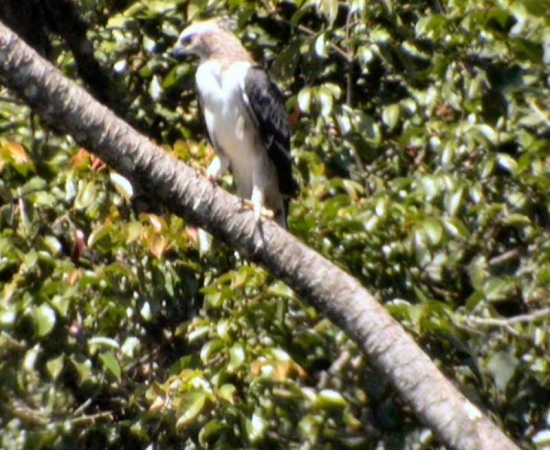m (Black-and-White Hawk-Eagle moved to Black-and-white Hawk-Eagle: Per Clements and H&M) |
|||
| Line 2: | Line 2: | ||
[[Image:Black_and_White_Hawk_Eagle.jpg|thumb|550px|right|Photo by petersheikhli]] | [[Image:Black_and_White_Hawk_Eagle.jpg|thumb|550px|right|Photo by petersheikhli]] | ||
==Identification== | ==Identification== | ||
| + | 50-60 cm. White head, neck and body, small crest forms a black spot on top of the head, black around the eyes, particularly towards the bill, black wings, brownish tail barred black-dark grey and with white tip, orange iris, pale to bright yellow feet with black talons, black bill with a yellow cere. Sexes similar, but female larger. | ||
| + | |||
| + | Immature birds - pale edges on upperwing coverts, brownish-grey back. | ||
| + | |||
==Distribution== | ==Distribution== | ||
Occurs in [[Mexico]], in Veracruz, Oaxaca, Chiapas and rarely Yucatan, in [[Central America]] south to [[Panama]] and in [[South America]] from [[Colombia]], [[Venezuela]], and the [[Guianas]] south to southern [[Brazil]], [[Paraguay]], and northern [[Argentina]]. Rare over most of range. Resident. | Occurs in [[Mexico]], in Veracruz, Oaxaca, Chiapas and rarely Yucatan, in [[Central America]] south to [[Panama]] and in [[South America]] from [[Colombia]], [[Venezuela]], and the [[Guianas]] south to southern [[Brazil]], [[Paraguay]], and northern [[Argentina]]. Rare over most of range. Resident. | ||
| Line 9: | Line 13: | ||
Forest from sea-level up to 1,500m, also forest edge and riverine woodland. | Forest from sea-level up to 1,500m, also forest edge and riverine woodland. | ||
==Behaviour== | ==Behaviour== | ||
| + | The diet includes mammals, toads, and a wide variety of birds. | ||
| + | It nests in the forest canopy, building a stick nest high up in exposed trees on ridges. | ||
==External Links== | ==External Links== | ||
{{GSearch|Spizastur+melanoleucus}} | {{GSearch|Spizastur+melanoleucus}} | ||
| − | [[Category:Birds]][[Category:Spizastur | + | [[Category:Birds]][[Category:Spizastur]] |
Revision as of 14:32, 3 November 2008
- Spizastur melanoleucus
Identification
50-60 cm. White head, neck and body, small crest forms a black spot on top of the head, black around the eyes, particularly towards the bill, black wings, brownish tail barred black-dark grey and with white tip, orange iris, pale to bright yellow feet with black talons, black bill with a yellow cere. Sexes similar, but female larger.
Immature birds - pale edges on upperwing coverts, brownish-grey back.
Distribution
Occurs in Mexico, in Veracruz, Oaxaca, Chiapas and rarely Yucatan, in Central America south to Panama and in South America from Colombia, Venezuela, and the Guianas south to southern Brazil, Paraguay, and northern Argentina. Rare over most of range. Resident.
Taxonomy
This monotypic species has been proposed moved from genus Spizastur to Spizaetus.
Habitat
Forest from sea-level up to 1,500m, also forest edge and riverine woodland.
Behaviour
The diet includes mammals, toads, and a wide variety of birds.
It nests in the forest canopy, building a stick nest high up in exposed trees on ridges.




